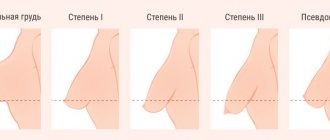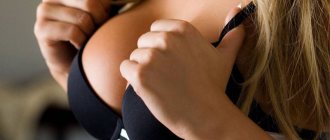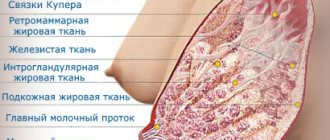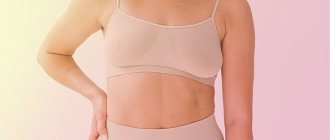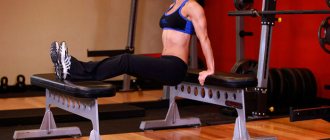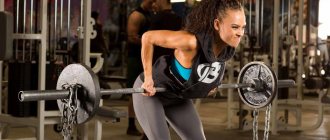Degrees of mastoptosis
Ptosis (mastoptosis) of the mammary glands is sagging of the breasts due to loss of elasticity and firmness, as well as a number of other reasons.
First of all, this is an aesthetic problem, which sometimes becomes psychological, as the woman begins to feel embarrassed about her body. This defect often occurs in girls. There are several degrees of mastoptosis. Normally, the nipple is located 5-7 cm above the inframammary fold located under the breast. Depending on the prolapse of the nipple, there are 3 degrees of ptosis:
- I - the nipple is lowered to the level of the pectoral fold, the sagging is unnoticeable;
- II - the nipple is located below the inframammary fold, ptosis is noticeable;
- III - the nipple is directed downwards, the sagging of the breast from the inframammary fold is more than 5 cm, pronounced.
In addition to the described degrees, pseudoptosis is also distinguished, in which the mammary glands sag, but the nipple is located above the fold. This type is typical for those with large breasts.
The presence of sagging is quite simple to determine: you need to place a pencil under the chest. If the mammary gland is of normal shape, the pencil falls off. If it persists, then we can talk about mastoptosis. To determine the degree of sagging, a measuring tape is needed to measure the distance from the nipple to the breast fold.
Dissatisfaction with the shape of women's breasts often becomes the cause of complexes and sometimes depression. Correction helps increase self-esteem and self-confidence, makes you feel attractive and young.
How to reduce breasts at home
It is quite possible to reduce breast size at home, without surgery and harm to health.
First of all, it should be noted that bust size is directly related to the amount of fat. Therefore, for owners of curvy figures, to solve the problem, it will be enough to get rid of extra pounds.
Diet
The fastest way to adjust your breast size without surgery is through a diet that helps you lose fat throughout your entire body, including the area around your bust. When the number of calories in the diet is reduced, it is the breast that reacts first. It is necessary to review the daily menu and, first of all, limit the consumption of water, salt, sugar and unhealthy fats.
Salt retains fluid in the body and slows down metabolism. Sugar promotes the growth of fat cells.
Products that are prohibited on the diet:
- canned food, pickles, smoked meats;
- sauerkraut;
- sweet soda;
- packaged juices;
- candies, milk chocolate and other sweets;
- bananas, persimmons, grapes, pineapples.
The emphasis is on fresh vegetables and fruits. The permissible daily salt intake is 0.5-1 teaspoon.
The usual number of calories per day is reduced by 400–500 units. To do this, adhere to the following recommendations:
- Instead of potato side dishes, use vegetable ones.
- Replace animal fats with Omega-3 and 6: flaxseed oil, nuts, fish oil.
- The menu includes dietary bread or baked goods made from wholemeal flour, red unpolished rice, buckwheat, and oatmeal.
- To replenish the body with protein, eat: chicken, fish and seafood, cottage cheese, milk, eggs.
- Reduce the size of portions: it is better to eat less, but more often.
- Follow the drinking regime: drink up to 2 liters of clean water per day.
To lose weight, the daily diet should have the following distribution of BJU: proteins - 50%, fats - 20%, carbohydrates - 40-45%. It is also important to drink vitamin and mineral complexes while losing weight.
Products that promote intensive weight loss in the chest area:
- celery, spinach and other greens: parsley, lettuce, dill;
- all types of cabbage;
- black radish;
- radish;
- asparagus; green pea;
- cucumbers
It is recommended to stew, boil or steam dishes. It is permissible to use a grill, but without using melted lard.
Beauty care
Getting rid of extra pounds inevitably leads to the appearance of stretch marks and sagging skin. Therefore, it is important to ensure proper breast care. Regular massage using special creams, oils and scrubs helps to increase tone and increase blood circulation. Recommended care measures:
- Massage the chest with your hands or a washcloth during water procedures. The nipple and surrounding area are not affected.
- Take a contrast shower daily.
- Carrying out light peeling with salt and milk once a month.
- Systematic cleansing of the skin in the chest area and application of cosmetics with a tightening effect.
- The use of various homemade masks based on fruits, honey, vegetables, cream and milk, cottage cheese.
It is recommended to use ready-made cosmetics designed to eliminate stretch marks. Typically, such products contain: vitamins, seaweed, aromatic oils, green tea. Breast reduction is facilitated by massage oils, which are gently rubbed into the skin or taken orally:
- Jojoba oil and grape seeds: combine in a ratio of 25 ml to 5 ml, add 2-3 drops of rose essential oil. Rub the skin on your chest daily.
- Flaxseed oil: take 2 tablespoons orally. But you should start with 1 teaspoon, gradually increasing to the required dosage.
- Limetta oil: mix jojoba oil (15 ml), grape seed (5 ml) and limetta oil (3-4 drops). Apply externally.
Along with this, it is recommended to consume fish oil, which reduces the level of estrogen in the body, the hormone responsible for bust growth.
Giving up bad habits such as smoking and drinking alcohol will help keep your breasts in beautiful shape. Prolonged exposure to the scorching sun has an adverse effect.
Visual reduction
It is recommended to resort to manipulations with the selection of wardrobe and underwear, which will visually hide large breast sizes:
- Choose bra models that hide the axillary area, have wide straps and closed cups. Girls can wear swimsuits with compact cups.
- They stop at elongated and semi-tight blouses (dresses) with undercuts.
- Avoid extended sleeves (this leads to loss of proportionality of the figure).
- Choose jackets with a loose fit and a deep neckline.
A well-chosen bra can visually reduce breast volume by 1-2 sizes.
The ideal option is fitted, but not tight, items made of light fabric. A loose fit is preferable, without tightness around the bust. Deep necklines and square necklines are prohibited.
When choosing the bottom part of clothing, preference is given to maxi skirts or just below the knees and flared trousers. In outerwear, stylists recommend avoiding voluminous decorative inserts: ruffles and flounces, wide collars, chest pockets. Drawing plays an important role in hiding flaws. The emphasis is on neat patterns, narrow vertical or diagonal stripes. Cross stripes are not allowed. Massive accessories (beads, pendants) are also prohibited.
The use of folk remedies
There are many folk remedies suitable for breast correction. It is recommended to use compresses.
With daily procedures it is possible to reduce bust volume to 4 cm.
From poppy
Required components:
- poppy heads - 100–120 g;
- pharmaceutical rose - 60–65 g;
- chamomile (flowers) - 50 g;
- oat bran - 110 g;
- sour cream (20% fat) - 200 g.
Preparation:
- Pour 500 ml of boiling water over chamomile, poppy and rose.
- Wait 45–50 minutes and add bran to the pure broth. Mix thoroughly.
- After 15–20 minutes, spread the mixture on a piece of gauze, apply a layer of sour cream on top and roll it up around the edges.
- Heat the compress in the microwave and apply it to the chest for half an hour. Turn over periodically.
From almonds and walnuts
For the compress you will need:
- almonds - 160 g;
- peeled walnuts - 120 g;
- egg yolk - 1 piece;
- natural honey - 55 g;
- butter - 30-33 g.
Recipe:
- Grind the yolk with honey and butter, beat with a mixer until smooth.
- Grind the nuts, then combine them with the previous mixture.
- Make a compress from gauze and keep it on your chest for at least an hour.
With honey
Required components:
- honey - 160–165 g;
- heavy cream - 50–55 ml;
- oat flakes - 50 g;
- mineral water with gas - 450 ml;
- sage and eucalyptus - 35 g each.
Recipe:
- The herbs are poured with mineral water and put on fire for 15 minutes.
- The liquid is filtered into a separate container and the remaining hot vegetables are mixed with honey and cream.
- Gauze folded in several layers is first dipped in the broth, after which the mass is applied to it.
- Cover the top with another layer of gauze and immediately apply it to the chest.
- Turn over every quarter of an hour and continue to do this for an hour.
The main causes of ptosis
There are many reasons why the mammary gland prolapses:
- hereditary factor;
- breast-feeding;
- age-related changes;
- fluctuations in body weight;
- changes in hormonal levels;
- macromastia and gigantomastia;
- smoking.
Let's look at each reason in more detail.
Breast-feeding
During pregnancy, the body prepares for childbirth and subsequent feeding of the child. Under the influence of hormones, the glands increase in size; when breastfeeding, they are filled with milk and increase in volume. After lactation, iron decreases, but stretched skin and ligaments can no longer return to their previous shape. The larger the breasts, and the longer the lactation period lasts, the more the mammary glands stretch.
Hereditary factor
The shape of a girl's breasts is largely determined by the elasticity of the skin and ligaments. This feature is determined by genetics, which is confirmed by many years of observation through family ties.
Age-related changes
Loss of elasticity in the skin and ligaments occurs with age. The body's production of collagen and elastin decreases, and the dermal framework becomes loose. The skin loses its elasticity and ability to support the weight of the glands. This primarily applies to large breasts.
Fluctuation in body weight
Breasts may sag if you gain excess weight. This happens because some of the fatty tissue is deposited in the breasts, its weight increases, and the skin stretches. Breasts can also sag after losing weight, when the fat layer decreases and excess skin forms, which causes ptosis.
Changes in hormonal levels
The glands enlarge even with minor hormonal changes, for example, before menstruation, but the breasts do not sag. Everything can change when serious hormonal disruptions occur in the body due to various endocrine diseases, which increase the risk of mastoptosis.
Gigantomastia
Large mammary glands have significant weight. The ligaments cannot constantly support such breasts; they lose elasticity and stretch over time.
Smoking
This habit, harmful to the body, increases the likelihood of mastoptosis, since nicotine inhibits the synthesis of elastin. The skin loses its elasticity and sags.
Why are my breasts sagging?
- Age-related changes . The volume of the mammary glands and glandular tissue decreases with age, muscles lose strength, and the skin stretches.
- Pregnancy and lactation . Sagging breasts after childbirth are a common problem. During this period, the breasts fill with milk and increase in size. After the end of lactation, the mammary glands become smaller, and the skin “cannot keep up” with them. In addition, the baby most often pulls the nipple down, and the breast gradually sag.
- Dramatic weight loss . An effective diet leads to the “burning” of excess fat tissue in the bust, and it loses support.
- Postural disorders . Sedentary work often leads to spinal deformation, weakening of the pectoral muscles and sagging of the bust.
- Incorrect care . Incorrectly selected underwear can lead to loss of shape.
Prevention of ptosis
The appearance of mastoptosis can be prevented. There are several measures to prevent breast sagging:
- Properly selected underwear is a good preventive measure against breast cancer. .
- Play sports. Well-developed muscles of the back and chest support the mammary glands well, so choose those sports that develop these muscle groups well, for example, gymnastics and swimming.
- Take care of your breast skin using cosmetics that stimulate the synthesis of elastin and collagen.
- Watch your weight. Avoid sudden weight gain and loss.
- Take a contrast shower to stimulate blood supply to the skin.
If breast ptosis does occur, mastopexy will help restore the previous shape.
Preparing for surgery
The preparatory period for surgical intervention includes consultation with a plastic surgeon, mammologist, examination, examination, and tests.
Surgeon consultation
At the appointment, the plastic surgeon collects anamnesis, clarifies genetic factors, previous diseases, and allergies to medications.
During the examination, the doctor determines the size of the gland, the degree of ptosis, the ratio of adipose and glandular tissue, structural features of the breast, and the presence of stretch marks. Depending on the degree of mastoptosis, an intervention technique is selected and an operation plan is drawn up. The surgeon clarifies whether the patient plans to lose weight and advises doing so before surgery. In addition to the surgeon, you will need to consult a therapist, and additionally, if there are concomitant diseases, other specialists.
Analyzes
Before surgery, you must have the following tests:
- general blood analysis;
- Rh factor and group;
- coagulogram;
- blood biochemistry;
- blood for HIV (f. 50);
- blood for glucose;
- for hepatitis B (HbsAg) and C (HCV), for syphilis (RW);
- general urine analysis.
Examination and diagnosis
The doctor orders a breast examination. Up to 35 years of age, it includes one ultrasound or MRI procedure, and after 35, a mammogram and two ultrasound examinations are required. Patients with chronic diseases and over 40 are prescribed additional tests.
It is mandatory to do a FLG or chest x-ray, an electrocardiogram with a conclusion. A consultation with an oncologist/mammologist and a physician’s report are required.
How is the procedure performed?
First, the woman is referred to a plastic surgeon for an examination. Before the breast lipofilling procedure, a diagnosis is carried out. A week before the procedure, avoid alcohol and blood thinning medications.
Lipofilling is carried out in three stages:
1. First, the specialist receives natural material - fat is pumped out from problem areas. For this, a special tube with a rounded end is used. The resulting subcutaneous fat is placed in a sterile container and sent for further processing.
2. The procedure for cleaning the collected material is carried out using a centrifuge and a special solution. This allows unnecessary tissue and blood to be separated from autologous fat, which will be transplanted into the patient’s mammary glands.
3. The purified mixture is injected in small portions into problem areas of the chest - subcutaneously, intramuscularly or between muscles, but not into the gland itself.
The success of the procedure largely depends on the professionalism of the doctor and adherence to technology. The result of correctly performed breast lipofilling can be assessed almost immediately visually and in a photo taken after the injection to compare the results.
Women who have tried the procedure of transplanting their own fat clearly see the results before and after breast lipofilling. Very often this encourages them to correct other flaws in their appearance using this technique.
Methods of performing the operation
Three main mastopexy techniques have been developed. The method of surgical intervention is chosen by the doctor. The method is determined by the degree of ptosis and the individual structure of the mammary gland.
Mastopexy is performed under general anesthesia. Anesthetics can be administered endotracheally or intravenously. The duration of the correction depends on the extent of the operation. If it is performed without endoprosthetics, it lasts from one and a half to three hours.
Periareolar
This type of technique is indicated only for stage I breast ptosis. The incision is made only around the circumference of the areola. During the operation, the glandular tissue is redistributed and the nipple and areola are moved slightly upward. The seam along the edge of the areola is almost invisible.
Vertical technique
It is used for stage II mastoptosis. The incision is made around the areola, then vertically down to the inframammary fold. The gland tissues are redistributed, raised to the upper pole and fixed. The nipple and areola are also tightened. The size of the areola can be reduced to improve the aesthetics of the breast.
Anchor (T-shaped) method
Performed for grade III ptosis. Before the operation, a marking is made along which the incision is made. The location of the nipple is determined.
The technique is considered classic, in which the incision is made in the shape of an anchor: first along the areola, then vertically down, then along the inframammary fold. During the operation, excess skin is also removed, the glandular and adipose tissue is shifted higher to the upper pole, fixed to the pectoral fascia, and the areola and nipple are moved.
Internal seams are made with absorbable threads. External tissues are sutured with polypropylene threads using a cosmetic suture. After 4 weeks they are removed. Drainage tubes are installed to remove serous fluid and blood. The drainage is usually removed the next day, sometimes a little later.
After the operation, compression garments and sometimes a bandage are worn, which relieves the stress on the sutures and supports the breast while healing.
How is the operation performed?
The technique that a plastic surgeon prefers for performing an operation is directly determined by the woman’s current condition. The attending physician examines the patient in advance, identifies the degree of sagging of the mammary glands, and then makes a diagnosis and method of surgery.
The breast reduction procedure is performed using the following techniques:
- Micro cuts. This method of surgery is used when the breasts do not sag and have excess fat that needs to be removed. Using a small incision and a catheter, the surgeon performs liposuction.
- Periareolar incision. In this case, the incision site is the edge of the breast areola.
- "Keyhole". It is carried out along the edge of the nipple and then goes down a little lower.
- "Anchor". This is a T-shaped incision that runs near the edge of the areola and descends vertically to the fold under the breast. Is the most popular way.
Complications that are characteristic of any operation, and not just mammoplasty, cannot be excluded - infection, swelling and hematomas, suture dehiscence and necrosis. But when the operation is performed by a professional and strict adherence to all his recommendations after the procedure, such complications are extremely rare.
Fadin Alexander Sergeevich plastic surgeon, Candidate of Medical Sciences
Rehabilitation period, advice from a plastic surgeon
After the correction, we leave the patient in the hospital for two days, then she is transferred to outpatient treatment with constant monitoring. After 2-4 weeks, the hematomas disappear, after 5-7 days the pain disappears, and after one month physical activity is restored.
For better healing of sutures and restoration of the shape of the mammary glands, I recommend following some rules:
- To reduce pain, you need to take non-steroidal analgesics for the first four days.
- It is necessary to take antibiotics to prevent mastitis and suppuration of the sutures. The seams need to be treated with antiseptic ointment.
- To make the seams invisible, treat them with a special gel.
- You must wear compression garments for at least six weeks. It helps relieve swelling and reduces the likelihood of stitches coming apart. For the first five days you should always be in this underwear, then you can take it off for a while.
- I recommend using a silicone patch along with compression garments.
- You should avoid hot baths and saunas for two months. You can take a warm shower after 5 days, at which time you can remove the compression garments for a short time.
- Avoid injuries and pressure on the glands throughout the recovery period.
- Sleep on your back for the first month of rehabilitation.
- For the first six months, heavy physical activity and physical education are prohibited. Increase the loads gradually.
- To speed up recovery, use physiotherapeutic procedures, for example, magnetic therapy, which improves metabolic processes and lymphatic drainage.
Results will become visible after two to three months, but full recovery will occur within a year.
Breast lift without surgery
Various procedures aimed at improving blood microcirculation, preserving and maintaining the elasticity of the skin and ligaments, and strengthening the muscles of the chest and back will help maintain the shape of the breast.
These include massage, which can be manual. Water or vacuum.
Physiotherapy procedures are considered safe and effective methods of tightening, such as:
- myostimulation;
- mesotherapy;
- biorevitalization;
- microcurrent.
Push-ups, palm rest, exercises with dumbbells and a punching bag will help strengthen your muscles.
To support the procedure, you can supplement with nutrients that stimulate blood circulation and elastin synthesis. These can be essential oils from plants such as ylang-ylang, grape seed, fennel, jojoba, hops, sage, geranium, hazel and others. To prevent women's breasts from sagging, cosmetic masks applied to the mammary glands give good results.
Proper nutrition for breast fat
It is important not only to exercise, but also to adhere to proper nutrition, then burning fat in the problem area will not take long.
First of all, you need to switch to fractional meals, replacing the standard three meals a day. Portions should be as small as possible (a slight feeling of fullness should occur), and you should eat every three hours. Such an approach to nutrition will speed up metabolic processes in the body; fat burning will be activated throughout the body, including in the chest area.
Be sure to read: Popular abdominal exercises for burning belly fat at home
Don't forget to drink water. During periods of active weight loss, the body should receive at least 2 liters of water. If you engage in active sports, your daily water intake increases by 2-3 glasses. It is water that allows you to remove harmful waste and toxins from the body that have accumulated as a result of excess weight.
Try to avoid fast carbohydrates as much as possible. They are digested very quickly by the body, make you feel hungry some time after eating and include additional snacks in your diet, which often result in an increase in the number on the scale. You should also avoid saturated fats. It would be preferable to replace them with olive oil, nuts, seeds, fish oil, and avocados.
When losing weight in the chest area, you should also include in your diet foods that activate fat burning processes in the body.

